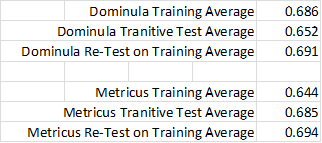"Transitive inference (TI) is a form of logical reasoning that involves using known relationships to infer unknown relationships
(A > B; B > C; then A > C).“TI has been found in a wide range of vertebrates” … and now in certain insects.
Tibbetts Elizabeth A., Agudelo Jorge, Pandit Sohini and Riojas Jessica. (2019). Transitive inference in Polistes paper wasps. 15. Biol. Lett.
http://doi.org/10.1098/rsbl.2019.0015
Published:08 May 2019https://doi.org/10.1098/rsbl.2019.0015
https://royalsocietypublishing.org/doi/10.1098/rsbl.2019.0015
This form of reasoning can be coded as a program, e.g.
if p(A,B) & p(B,C)
then p(A,C)
where p is any of a set of relational properties (larger than, stronger than, etc.)
Tibbetts is quoted in the NYT:
“They are organizing all those pairs into a linear hierarchy".
The paired items are relationships. They may be called dominance relationships, or it may be that something like perception of threat is involved. If wasp A has beaten wasp B, and wasp B has beaten wasp C, then those wasps perceive that wasp A can beat wasp C and will do so if the contest is tried.
This might be a perception of relationship among relationship perceptions. We already know that this appearance of recursion is possible. At a lower level, for example, we may perceive a configuration that is made up of configurations.
TTTTTTTTTTTT
TTT
TTT
TTT
TTT
TTT
Transitive inference may also predicated upon set membership, as may be expressed by formulations such as this:
if a ∈ {A} & {A} ∈ {B}
then a ∈ {B}
Returning to the report by Tibbets et al., the set of wasps that A can beat includes the sets of wasps that they each can beat.
The set of wasps that A can beat includes the sets of wasps that any of them can beat.
These sets look like Bill’s notion of Category perceptions. A set or category may be defined criterially (x is a member of {A} if certain perceptual input functions fire [in sufficient number or strength] when the perception x synapses with them) or it may be defined by exemplars (p, q, and r are definitely members of {A}, and sufficient number/strength of the same perceptual input functions which fire upon perceiving one of the exemplars also fire upon perceiving x). Defining by inclusion criteria is generally thought to be formally different from defining by by similarity to central exemplars , but, as you can see, when we put it in terms of perceptual signals these formally different ways of defining set membership amount to the same thing.
Now, it is a different question entirely whether or not there may be a distinct order or level of perceptual input functions which receive those criterial (or exemplar-like) perceptual signals and produce for each set or category a single perception that “some member of {A} is present” (for each set {A}). Personally, I suspect that, rather than higher-level comparators receiving Category perceptions, the ‘categorizing’ is done by the perceptual input functions for those higher-level comparators. Those that control by means of some of the same perceptual inputs are thereby associated with each other. Since memory is local to each synapse, they are associated in memory. And that may be sufficient basis for ‘transitive inference’.
Just because a control phenomenon sounds like logic or reasoning and can be coded as a program, that does not signify that it involves perceptual control at a Program level.
